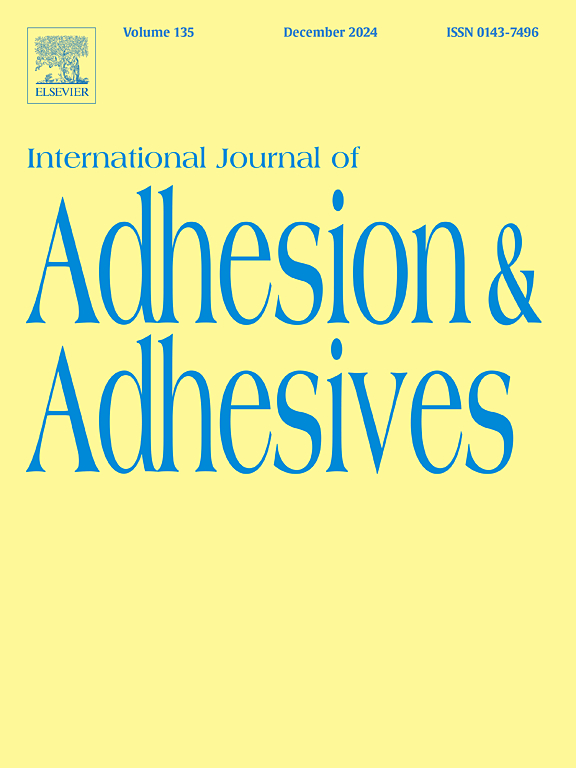Incorporation of epigallocatechin-3-gallate absorbed onto hydroxyapatite nanoparticles in dental adhesive: Impact on resin dentin-bonding, chemical, and mechanical properties
IF 3.5
3区 材料科学
Q2 ENGINEERING, CHEMICAL
International Journal of Adhesion and Adhesives
Pub Date : 2025-03-26
DOI:10.1016/j.ijadhadh.2025.104019
引用次数: 0
Abstract
To evaluate the resin-dentin bond strength, chemical and mechanical properties of experimental etch-and-rinse (E&R) and self-etch (SE) adhesives doped with epigallocatechin-3-gallate (EGCG) adsorbed on hydroxyapatite (HAp) nanoparticles. The groups were divided according to the concentration of HAp/EGCG (epigallocatechin-3-gallate adsorbed on hydroxyapatite nanoparticles) (% wt) and bonding strategies (E&R or SE): 1) Control SE (0 %), 2) Control E&R (0 %), 3) SE-HAp/EGCG 1 %, 4) E&R-HAp/EGCG 1 %, 5) SE-HAp/EGCG 5 % and 6) E&R-HAp/EGCG 5 %. Nanoparticles were incorporated into experimental adhesives. Bar-shaped specimens (n = 6) were prepared to assess flexural strength (FS) and elastic modulus (EM), and the degree of conversion (DC, n = 5) was assessed by Fourier transform infrared spectroscopy. Sixty human third molars were sectioned and restored for microtensile bond strength testing (μTBS, n = 10) at 24 h and 6 months in distilled water. Data were analyzed by three-way ANOVA (μTBS) or two-way ANOVA (DC, FS, EM) and Tukey's post-test (α = 0.05). FS and EM increased significantly in the 5 % SE-HAp/EGCG group compared to the control group (p < 0.05). EM decreased significantly in the 1 % SE-HAp/EGCG group, while FS increased in the E&R mode. The addition of HAp/EGCG increased the DC adhesives. For μTBS at 24 h, the E&R- HAp/EGCG 1 %–5 % groups displayed the highest values. After 6 months, HAp/EGCG 1 % (E&R and SE) maintained bond strength (p < 0.001), while the SE control group exhibited a significant decrease in μTBS values. Adhesive failure was predominant in all groups. Incorporating 1 % HAp/EGCG into E&R adhesives enhanced bonding performance, monomer conversion, and material strength, while the 5 % concentration compromised dentin bonding and physicochemical properties.
没食子儿茶素-3-没食子酸酯被羟基磷灰石纳米颗粒吸收到牙胶中:对树脂牙本质结合、化学和机械性能的影响
以羟基磷灰石(HAp)纳米颗粒为载体,研究掺杂表没食子儿茶素-3-没食子酸酯(EGCG)的实验性蚀刻-冲洗(E&;R)和自蚀刻(SE)胶粘剂的树脂-牙本质结合强度、化学和力学性能。根据羟基磷灰石纳米颗粒吸附的表没食子儿茶素-3-没食子酸酯的HAp/EGCG浓度(% wt)和键合策略(E&;R或SE)进行分组:1)对照SE(0%), 2)对照E&;R (0%), 3) SE-HAp/EGCG 1%, 4) E&R-HAp/EGCG 1%, 5) SE-HAp/EGCG 5%, 6) E&R-HAp/EGCG 5%。将纳米颗粒掺入实验粘合剂中。制作条形试件(n = 6),评估其抗弯强度(FS)和弹性模量(EM),并通过傅里叶变换红外光谱评估其转换程度(DC, n = 5)。取60颗人第三磨牙切片,分别于24 h和6个月在蒸馏水中进行微拉伸粘结强度测试(μTBS, n = 10)。采用三向方差分析(μTBS)或双向方差分析(DC、FS、EM)和Tukey后验检验(α = 0.05)对数据进行分析。与对照组相比,5% SE-HAp/EGCG组FS和EM显著升高(p <;0.05)。在1% SE-HAp/EGCG组,EM显著降低,而在E&;R模式下,FS升高。HAp/EGCG的加入提高了DC胶黏剂的性能。24 h时,E&;R- HAp/EGCG 1% ~ 5%组的μTBS值最高。6个月后,HAp/EGCG 1% (E&;R和SE)保持了结合强度(p <;0.001),而SE对照组的μTBS值显著降低。粘接失败在所有组中均占主导地位。在E&;R粘合剂中加入1%的HAp/EGCG可以增强粘合性能、单体转化率和材料强度,而5%的HAp/EGCG会降低牙本质粘合和物理化学性能。
本文章由计算机程序翻译,如有差异,请以英文原文为准。
求助全文
约1分钟内获得全文
求助全文
来源期刊

International Journal of Adhesion and Adhesives
工程技术-材料科学:综合
CiteScore
6.90
自引率
8.80%
发文量
200
审稿时长
8.3 months
期刊介绍:
The International Journal of Adhesion and Adhesives draws together the many aspects of the science and technology of adhesive materials, from fundamental research and development work to industrial applications. Subject areas covered include: interfacial interactions, surface chemistry, methods of testing, accumulation of test data on physical and mechanical properties, environmental effects, new adhesive materials, sealants, design of bonded joints, and manufacturing technology.
 求助内容:
求助内容: 应助结果提醒方式:
应助结果提醒方式:


